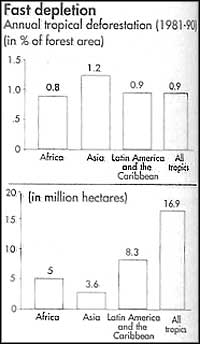Fastest loss of forests in Asia
 ASIA TOPS the list of continents with the highest deforestation rate. The initial estimates of the 1990 tropical forest resources census show about 3.6 million ha -- or about 1.2 per cent -- of forest land are cleared each year in Asia. This is much higher than in either Latin America or Africa, according to the survey conducted by the Food and Agriculture Organisation (FAO).
ASIA TOPS the list of continents with the highest deforestation rate. The initial estimates of the 1990 tropical forest resources census show about 3.6 million ha -- or about 1.2 per cent -- of forest land are cleared each year in Asia. This is much higher than in either Latin America or Africa, according to the survey conducted by the Food and Agriculture Organisation (FAO).
The 1981-90 study shows that 36 per cent of the world's tropical land area -- 1.7 billion ha -- was forested. Of this, Latin America and the Caribbean had the largest forest cover -- 50 per cent of Latin America's land area or 840 million ha. Asia followed with 31 per cent and finally Africa with 27 per cent.
The study classified tropical forests into six zones: rainforest, moist deciduous, dry deciduous, very dry, desert and hill/montane. It showed about three-fourths of tropical forests are in the rainforest or moist deciduous zones. It estimated overall annual deforestation at 0.9 per cent or 16.9 million ha and said it is highest in the moist deciduous and hill/montane zones. In terms of annual forest loss, the big-time losers are the moist deciduous zone (7.3 million ha per year) and the tropical rainforest zone (4.9 million ha annually). But the hill/montane zone is the most threatened because there is relatively small forest area left.
During the survey period, tropical Africa annually lost about 0.8 per cent or 5 million ha of its forests, with the deforestation rate highest in areas with high population densities and growth. Degradation was maximum in the hill/montane regions of Ethiopia and Kenya.
In Asia, too, the story was the same. Areas with high population densities and growth lost more of their forest cover and at a much faster rate. Thus, though one-third of the continent is still under forest cover, only the rainforest zone has more than half (54 per cent) land area under forests. All the other zones have lost major portions of their forest cover.
In Latin America, deforestation in tropical rainforests remained low at just 0.6 per cent, unlike in Asia and Africa. The report stated the low population density in Latin America is the main reason for the lower pressure on forests.
Changes in national land use are one of the most important results of the survey. For instance, along the border of Laos and Myanmar, the increase in deforested areas is more due to progressive degradation than usurping of forest land for agriculture, though there has been an increase in the area under shifting cultivation.
The FAO findings reveal a need for a system of continuous national, regional and global monitoring of fast-depleting forest resources. As the report concludes, "The current state of the forest resources and the depth of concern for their conservation, demand nothing less."
